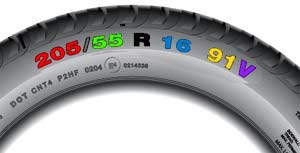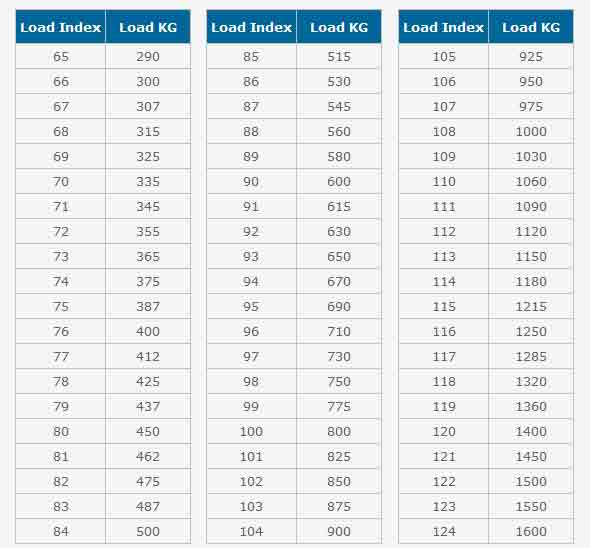 Part
of the tyre size are two digits that most motorists are unaware of or
don't know what they mean. The two digits before the speed rating symbol
as show in the diagram as 91V are the load rating. The load-rating is
essentially the maximum weight the tyre can carry. Tyres have different
load ratings but generally a tyre of the same size usually are the same.
Lower profile sizes tend to have lower load ratings compared to higher
profile ones. If you are considering changing your tyre size either up
sizing or down sizing the load rating should be the same or higher than
the original fitment. Fitting an incorrect load rating is seriously
compromising on safety and can result in a serious accident. Load
ratings can vary even when the size is the same as some tyres come as
standard load ratings and others have been further strengthened. These
types usually have the acronym 'XL' or 'RF' on the sidewall this means
the tyre structure has been reinforced meaning it can more weight. The
XL type are necessary for vehicles that carry more than 5 people and
some estate vehicles that carry more wieght in the boot. A common car
size 215/55/16 has a load capacity of 93 which reading of the chart
equates to 650kg per wheel. Including the load of the vehicle anything
extra including the passengers should not go over the 650kg or 1300kg
(calculated for two tyres) over the axle distributed evenly. The same
size 215/55/16 also comes in the XL version and this tyre has load
rating of 97 which equates to 730kg, hence there is a clear advantage of
80kg per tyre. Generally speaking if you fit the correct size you
should have the correct rated tyres but make sure as mentioned above you
may need the XL and RF version read the load index rating as well
before you make any purchase.
Part
of the tyre size are two digits that most motorists are unaware of or
don't know what they mean. The two digits before the speed rating symbol
as show in the diagram as 91V are the load rating. The load-rating is
essentially the maximum weight the tyre can carry. Tyres have different
load ratings but generally a tyre of the same size usually are the same.
Lower profile sizes tend to have lower load ratings compared to higher
profile ones. If you are considering changing your tyre size either up
sizing or down sizing the load rating should be the same or higher than
the original fitment. Fitting an incorrect load rating is seriously
compromising on safety and can result in a serious accident. Load
ratings can vary even when the size is the same as some tyres come as
standard load ratings and others have been further strengthened. These
types usually have the acronym 'XL' or 'RF' on the sidewall this means
the tyre structure has been reinforced meaning it can more weight. The
XL type are necessary for vehicles that carry more than 5 people and
some estate vehicles that carry more wieght in the boot. A common car
size 215/55/16 has a load capacity of 93 which reading of the chart
equates to 650kg per wheel. Including the load of the vehicle anything
extra including the passengers should not go over the 650kg or 1300kg
(calculated for two tyres) over the axle distributed evenly. The same
size 215/55/16 also comes in the XL version and this tyre has load
rating of 97 which equates to 730kg, hence there is a clear advantage of
80kg per tyre. Generally speaking if you fit the correct size you
should have the correct rated tyres but make sure as mentioned above you
may need the XL and RF version read the load index rating as well
before you make any purchase.
